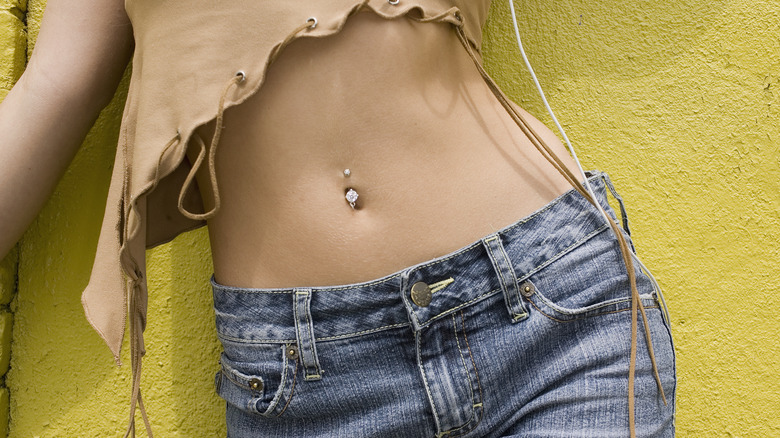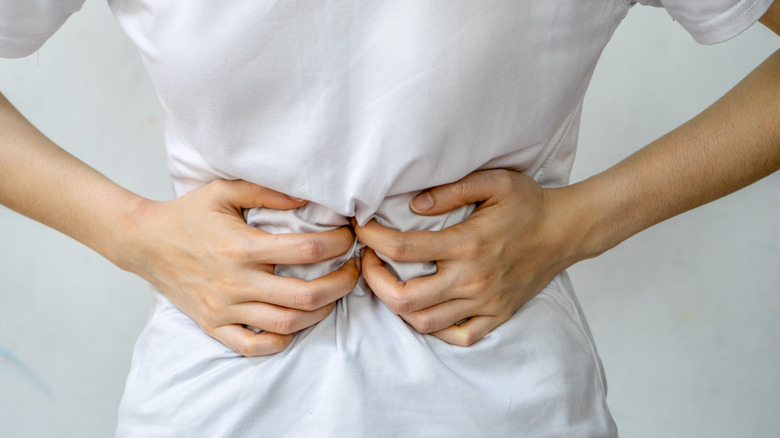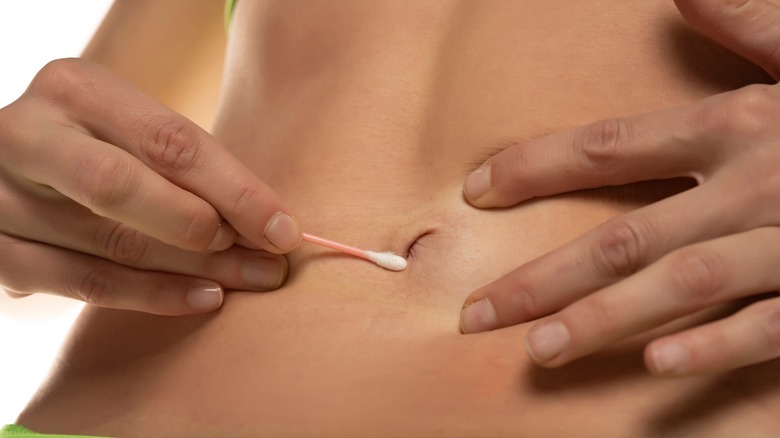Weird Things That Can Leak Out Of Your Belly Button
TikTok and Instagram influencers will draw millions of views for their skincare routines. These could involve the face, the arms, or decolletage. But what about the belly button? Your belly button doesn't need a special skincare routine, but ignoring your belly button hygiene can result in some smelly discharge. After all, sweat from your workouts, dirt, lint, and maybe tequila from your last trip to Cancun can collect in that little cave, even if your belly button is an outie.
While some belly button discharge is harmless, a mix of all these ingredients can eventually lead to various types of infections, especially if you have a belly piercing, obesity, or diabetes. Some belly button discharge comes from poor hygiene after a recent surgery.
In an exclusive interview with Health Digest, Chief Medical Officer and Physician at One Oak Medical Dr. Jason Singh described which belly button secretions are normal. "Normal discharge is typically clear or light-colored, slight odor (similar to sweat), no pain or redness around the navel," he said. However, some belly button discharges might warrant a trip to the doctor.
Bacterial or yeast infections in the belly button
Singh says the most common funk you might encounter in your belly button is a bacterial or fungal infection. "This occurs due to poor hygiene, excessive sweating, or trapped moisture," he said. "Other conditions include navel piercings, cysts, and skin conditions like eczema or psoriasis." People with diabetes are particularly susceptible to fungal infections such as candidiasis if their blood sugar isn't under control, according to a 2019 review in the Journal of Clinical Medicine.
Bacteria and fungi love the dark environment of your belly button. If your belly button is infected, you might notice some redness or swelling. The discharge might look like pus, making your belly button smell bad. If it's a yeast infection, your belly button might also itch.
Your doctor might suggest an over-the-counter antifungal cream if it's a fungal infection, but you might need a prescription antibiotic if it's a bacterial infection. "You should [also] see a doctor if symptoms persist after several days, if you have diabetes or a weakened immune system, if experiencing pain and fever, or if you suspect you have a navel piercing infection," Singh said.
Less common belly button discharges
Some belly button infections result from other conditions. "Concerning discharge is typically high volume of secretions, it's yellow/green/or brown in color, strong unpleasant odor, accompanied by pain/redness/swelling, can have blood mixed in it, and cause systemic symptoms like fever or chills," Singh said. If you've recently had a hernia or laparoscopic surgery, your belly button could become infected if it's near the incision. This discharge might appear like pus.
If you notice the discharge is cloudy or bloody, you may have a urachal cyst infection. The urachus connected your umbilical cord with your bladder when you were a developing fetus. Although the urachus often disappears before you are born, some people still have part of it. A urachal cyst can form on the urachus at any age, and it can become infected. Along with a discharge, an infected urachal cyst could also have symptoms such as abdominal pain, chills, fever, and pain while urinating.
A yellow discharge with an unpleasant odor in your belly button could be an infected epidermoid cyst. An epidermoid cyst can develop if you have a blocked hair follicle. The yellow discharge comes from the ruptured, infected cyst that's filled with keratin. If the cyst is infected, your doctor will need to drain the cyst and eventually remove it.
How to keep your belly button clean
Your belly button is a pretty diverse environment for bacteria. According to a 2012 article in PLoS ONE, you could have more than 2,300 species of bacteria living in your belly button right now. Similar to your gut microbiome, some bacteria help fight off pathogens. That's why you should properly clean your belly button, but don't feel you have to adopt a 7-step regimen like skincare. Lotions or creams can make your belly button more friendly to unwanted bacteria and yeast.
"For home care, I typically suggest gently cleaning the belly button daily with mild soap and water, dry the area thoroughly after cleaning, and if minor irritation is noticed then consider OTC antibiotic treatment," Singh said. To get all the dirt and lint hiding in those little wrinkles and folds, you can use a cotton swab, a washcloth, or even your fingers.
Summer heat can lead to more sweat collecting in your belly button, so be sure your clothing is loose and made from breathable fabric, such as cotton. If you have or plan to have your belly button pierced, be sure to have it done by a qualified professional who will use proper sterilization procedures. You'll also need to follow the proper protocol for caring for the piercing, such as washing the area twice a day.



